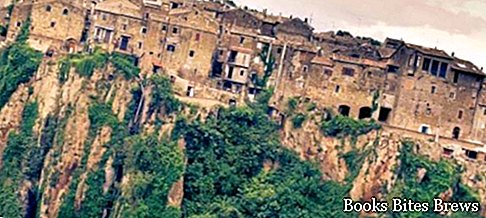What to see in Calcata, itinerary including the main monuments and places of interest, including the baronial castle, tea room, Treja park, archaeological area and Monte Gelato waterfalls.
Tourist information
Located in the province of Viterbo, about forty kilometers from Rome, Calcata is located on a tuff rock placed in the valley of the Treja river, in a secluded position that has favored the conservation over time of cultural and artistic traditions.
The medieval village was affected in the thirties by crumbling of the tufa rock on which it was built, a factor that made it declare temporarily unusable.
Later on, various artists, originating from every part of Italy, came to open their shops in this place, looking for a quiet place that would encourage their creative inspiration and that was far from the typical confusion of big cities.
About the origins of Calcata, some archaeological excavations have brought to light some traces of prehistoric settlements, moreover the area was also affected by settlements of Faliscan civilization, a culture widespread in the entire Tuscia Tiberina, similar to the Etruscan but even more ancient.
The traces of a large Faliscan inhabited center can be seen in the various finds found near Calcata, including the remains of the city of Narce, at whose feet there is an example of a Faliscan temple, the Necropolis of Pizzo Piede, to reach which must follow a path on which it is possible to see a gigantic monolith, on which there are carved steps, probably part of a watchtower.
These peoples believed the territory of Calcata to be a sacred place, the fulcrum of particular energies and where magical and propitiatory rites shrouded in mystery were put in place, as they were perhaps closely linked with remote astral cults.
The name of Calcata made its appearance for the first time in a text dating back to 781, then, in 1200, the village became a fief of the Anguillara, a noble family who built the castle and the city walls.
A village that can only be visited on foot, Calcata is on the whole an evocative ancient village, even if there are no monuments of particular importance.
The houses covered with blocks of exposed tuff and the twisted streets, which lead to exceptional panoramic points on the Treja gorges, make the visit of Calcata a unique experience.
What see
Surrounded by fortified walls, and defended at the same time by the morphological characteristics of its own natural environment, Calcata is a village which is accessed only through a single medieval double entrance door, passing through which you enter the Renaissance Piazza Vittorio Emanuele II, where there are three unusual tuff thrones, created by Costantino Morosin, one of the major local artists.
Recommended readings- Anagni (Lazio): what to see
- Lazio: Sunday day trips
- Vetralla (Lazio): what to see
- Ciociaria (Lazio): what to see in the historic region
- Alatri (Lazio): what to see
From this square, various narrow streets start, along which you will find arches, stairways, artisan shops, tea rooms and small restaurants where excellent typical local dishes are served.
Below the street level, several houses include caves, frequently divided on different floors, which in the past were probably tombs or places of worship, while today they are used as cellars.
Some tuff houses dating back to 1200 have the appearance of modest houses, characterized by ancient portals, while the streets are paved with large river pebbles positioned in the 1700s.
The Baronial Castle, next to which the Ghibelline tower stands, was built by the Anguillara family in the thirteenth century.
The name of the Sinibaldi marquises, owners of the village during the twelfth and thirteenth centuries, was engraved on the plaque of the castle, later it was acquired by the Anguillara counts until the first half of the eighteenth century, to return to the possession of the Sinibaldi in the following period, on the occasion of the remaking of the whole building.
Currently the building belongs to the Valle del Treja Park, of which it houses offices and a dedicated visitor center, it is also a place usually used for civil weddings, exhibitions, conferences and exhibitions of various kinds.
The church of the Most Holy Name of Jesus, dating back to the fourteenth century and remodeled in 1793 on behalf of the Sinibaldi family, has an interior with a single nave, covered by a wooden trussed ceiling, where a baptismal font, a font of the sixteenth century and a wall tabernacle.
Behind the altar you can admire a series of paintings with scenes from the life of Jesus as subject.
Among the places worth visiting in Calcata is also the Granarone, an ancient barn dating back to 1632, currently the seat of the Granarone cultural association.
Do not miss a visit to the 201 Tea Room, a place where it is possible to consume over two hundred different types of tea from various parts of the world, with the possibility of tasting the best products of the renowned local pastry shop.
In Colle, near Calcata, there is the Opera Bosco Museum, open to the public since 1996 and born from an idea by the artists Anne Demijttenaere and Costantino Morosin.
It is a naturalistic itinerary that, through paths, crosses two hectares of forest, giving the opportunity to view, surrounded by vegetation, about forty works, made exclusively with natural materials.
In the Treja Park, the Monte Gelato waterfalls deserve to be seen, together with the overlying ruins of an ancient water mill.
It is a path, characterized by various mills and waterfalls, which allows you to get to the important archaeological area in the park, where there are many necropolises and ancient finds dating back to the Bronze Age.




